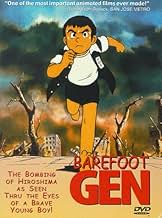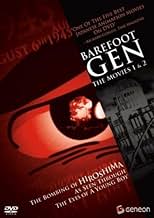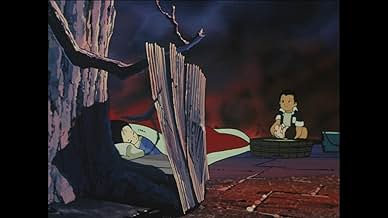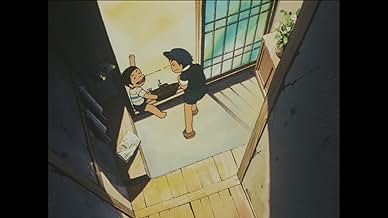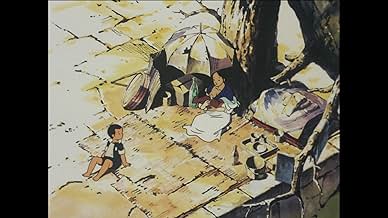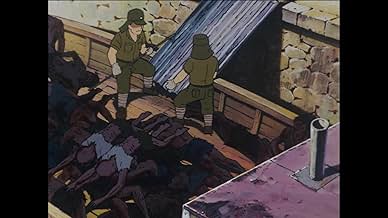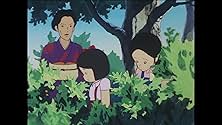CALIFICACIÓN DE IMDb
8.0/10
9.9 k
TU CALIFICACIÓN
Relata la historia del efecto de la bomba atómica en la vida de un niño y en la vida del pueblo japonés.Relata la historia del efecto de la bomba atómica en la vida de un niño y en la vida del pueblo japonés.Relata la historia del efecto de la bomba atómica en la vida de un niño y en la vida del pueblo japonés.
- Premios
- 1 premio ganado en total
Issei Miyazaki
- Gen
- (voz)
Catherine Battistone
- Gen (1995)
- (English version)
- (voz)
Iona Morris
- Kimie (1995)
- (English version)
- (voz)
Masaki Kôda
- Shinji
- (voz)
- …
Brianne Brozey
- Shinji (1995)
- (English version)
- (voz)
- (as Brianne Siddal)
Barbara Goodson
- Ryuta (1995)
- (English version)
- (voz)
Takao Inoue
- Daikichi
- (voz)
Kirk Thornton
- Daikichi (1995)
- (English version)
- (voz)
- (as Kurk Thornton)
Seiko Nakano
- Eiko
- (voz)
Wendee Lee
- Eiko (1995)
- (English version)
- (voz)
Takeshi Aono
- Eizo
- (voz)
Michael McConnohie
- Eizo
- (English version)
- (voz)
- (as Amike McConnohie)
- …
Katsuji Mori
- Seiji
- (voz)
Taeko Nakanishi
- Hana
- (voz)
Junji Nishimura
- Pak
- (voz)
Ardwight Chamberlain
- Pak
- (English version)
- (voz)
- …
Opiniones destacadas
This is the sort of movie that I would rate up there with Schindler's list. Its haunting and powerful. This is also the sort of movie that I feel that every history teacher who teaches American History should show their students at some point in time. While some of the scenes do get a bit annoying, it still brings home the horrors of what occurred at the end of World War II. The other thing is the point of view, which was not "anti American" and doesn't try and place blame, which makes this all the more powerful.
I've basically pasted this from wikipedia, but since the autobiographical element to this story wasn't mentioned I thought I should post it. There is an interesting article with the artist here http://www.tcj.com/256/i_nakazawa.html (中沢 啓治, Keiji Nakazawa, born 1939) is a Japanese manga artist and writer.
He was born in Hiroshima, and was in the city when it was destroyed by an atomic bomb in 1945. All of his family members who had not been evacuated died in the bombing except for his mother, and an infant sister who died several weeks after the bombing.
In 1961, Nakazawa moved to Tokyo to become a full-time cartoonist, and produced short pieces for manga anthologies such as Shonen Gaho, Shonen King, and Bokura.
In 1966, following the death of his mother, Nakazawa returned to his memories of the destruction of Hiroshima and began to express them in his stories. Kuroi Ame ni Utarete (Struck by Black Rain), the first of a series of five books, was a fictional story of Hiroshima survivors involved in the postwar black market. In 1972, Nakazawa chose to portray his own experience directly in the story "Ore wa Mita" ("I Saw It"), published in Monthly Shonen Jump (In 1982, the story was translated into English and published as a one-shot comic book by Educomics as "I Saw It").
Immediately after finishing "I Saw It", Nakazawa began his major work, Hadashi no Gen (Barefoot Gen). This series, which eventually filled ten volumes (six volumes in English translation), was based on the same events as "I Saw It" but fictionalized, with the young Gen as a stand-in for the author. Barefoot Gen depicted the bombing and its aftermath in graphic detail, but also turned a critical eye on the militarization of Japanese society in the World War II years, and on the sometimes abusive dynamics of the traditional family. Barefoot Gen was made into an animated film, released in 1983. It was followed three years later by a sequel.
He was born in Hiroshima, and was in the city when it was destroyed by an atomic bomb in 1945. All of his family members who had not been evacuated died in the bombing except for his mother, and an infant sister who died several weeks after the bombing.
In 1961, Nakazawa moved to Tokyo to become a full-time cartoonist, and produced short pieces for manga anthologies such as Shonen Gaho, Shonen King, and Bokura.
In 1966, following the death of his mother, Nakazawa returned to his memories of the destruction of Hiroshima and began to express them in his stories. Kuroi Ame ni Utarete (Struck by Black Rain), the first of a series of five books, was a fictional story of Hiroshima survivors involved in the postwar black market. In 1972, Nakazawa chose to portray his own experience directly in the story "Ore wa Mita" ("I Saw It"), published in Monthly Shonen Jump (In 1982, the story was translated into English and published as a one-shot comic book by Educomics as "I Saw It").
Immediately after finishing "I Saw It", Nakazawa began his major work, Hadashi no Gen (Barefoot Gen). This series, which eventually filled ten volumes (six volumes in English translation), was based on the same events as "I Saw It" but fictionalized, with the young Gen as a stand-in for the author. Barefoot Gen depicted the bombing and its aftermath in graphic detail, but also turned a critical eye on the militarization of Japanese society in the World War II years, and on the sometimes abusive dynamics of the traditional family. Barefoot Gen was made into an animated film, released in 1983. It was followed three years later by a sequel.
Barefoot Gen is the autobiographical story of manga artist, Keiji Nakazawa and his experience during the times of the Hiroshima bombings in 1942. What ensues is something so unbelievable, so gritty, so real, it will change your life forever.
The film is adapted as an anime from Keiji's short manga series depicting all that he experienced just at the age of six when the bombings hit. His story truly is one of the most amazing things you will ever hear. Nothing else in film has ever captured the effects of the bombings in such a real and emotional way. It shows the viewers what really did happen and what we were never told. It shows us how real the bombings really were as we follow Gen through his struggle for survival during Japan's darkest hours.
If you haven't seen this film, you are missing out. While the film does not hold back on the gritty details, and what happens to the people of Japan throughout the whole of the film is very horrifying, you cannot miss this film due to these aspects. It's these things that make it so real and it would be a tragedy to ignore this film. It opened my eyes to what really went down in Hiroshima and I almost felt personally affected. During my whole time watching this film, I kept finding myself in disbelief that something like this actually occurred in our history, and recently at that. I mean, a whole society was rebuilt on the effects of the bombings and once again shows us how very, very wrong war is. One of the best films I have ever seen.
9.5/10 Hamish Kearvell A.K.A Screaming Japan Productions - www.myspace.com/screamingjapanproductions
The film is adapted as an anime from Keiji's short manga series depicting all that he experienced just at the age of six when the bombings hit. His story truly is one of the most amazing things you will ever hear. Nothing else in film has ever captured the effects of the bombings in such a real and emotional way. It shows the viewers what really did happen and what we were never told. It shows us how real the bombings really were as we follow Gen through his struggle for survival during Japan's darkest hours.
If you haven't seen this film, you are missing out. While the film does not hold back on the gritty details, and what happens to the people of Japan throughout the whole of the film is very horrifying, you cannot miss this film due to these aspects. It's these things that make it so real and it would be a tragedy to ignore this film. It opened my eyes to what really went down in Hiroshima and I almost felt personally affected. During my whole time watching this film, I kept finding myself in disbelief that something like this actually occurred in our history, and recently at that. I mean, a whole society was rebuilt on the effects of the bombings and once again shows us how very, very wrong war is. One of the best films I have ever seen.
9.5/10 Hamish Kearvell A.K.A Screaming Japan Productions - www.myspace.com/screamingjapanproductions
Seeing this one at 7 was something to remember. The picture, the sound, the message, the dialogues, the actions. The atomic bombing looked so frightening on a big screen: the people were burning, their flesh – melting, and finally only bones remained.
Some Russian people still recall memories of this cartoon, though, it still has not been officially released in good quality. It must mean something. The animation film was shown decades ago in our theatres and since then has been erased from any means of media - but we still remember it and respect it. "Finding Nemo" is good. "Spirited Away" is better. But this one is a masterpiece that has real history as a background.
Judging by the number of votes, not so many IMDb visitors are aware of this gem. Alas, before making atomic quarrels one should watch this film. You cannot watch it and pass by ignorant.
My mark is a definite 10. Thank you for attention.
Some Russian people still recall memories of this cartoon, though, it still has not been officially released in good quality. It must mean something. The animation film was shown decades ago in our theatres and since then has been erased from any means of media - but we still remember it and respect it. "Finding Nemo" is good. "Spirited Away" is better. But this one is a masterpiece that has real history as a background.
Judging by the number of votes, not so many IMDb visitors are aware of this gem. Alas, before making atomic quarrels one should watch this film. You cannot watch it and pass by ignorant.
My mark is a definite 10. Thank you for attention.
Many compare Grave of the Fireflies with Hadashi no Gen/Barefoot Gen. While there are certainly similarities, such as the timeline taking place near the end of the war with Japan, the main difference is that Grave deals mostly with the inhumanity of the Japanese people toward their own kind, while Gen revolves less on this than it does the overall horrors of the after-effects of the nuclear blast at Hiroshima. The hooks used in the respective animes are thus, quite different. While Grave makes one shake their head and wonder about how humanity is sacrificed on the altar of survival and self-centeredness, Gen rests heavily on the outright horror that the dropping of Fat Man unleashed on an entire population.
Animation styles are vastly different also. Grave was made in conjunction with Miyazaki of studio Ghibli (Totoro), and thus was very polished in appearance. Gen, on the other hand, has a mostly "old-fashioned" anime feeling, reminiscent of the "Golden Age of Anime" in the 80's, using devices that are very manga; overblown representations of runny noses and buckets of tears from characters, for example.
In the end, Hadashi no Gen should be on the shelf of every anime collector. When someone says to them that anime is "just for kids", pop this in the VCR and show them just how in-depth, heart wrenching and thought provoking simple pen and ink cells can become. You will have to watch it twice; it's hard to get all the nuances while wiping tears from your eyes.
Animation styles are vastly different also. Grave was made in conjunction with Miyazaki of studio Ghibli (Totoro), and thus was very polished in appearance. Gen, on the other hand, has a mostly "old-fashioned" anime feeling, reminiscent of the "Golden Age of Anime" in the 80's, using devices that are very manga; overblown representations of runny noses and buckets of tears from characters, for example.
In the end, Hadashi no Gen should be on the shelf of every anime collector. When someone says to them that anime is "just for kids", pop this in the VCR and show them just how in-depth, heart wrenching and thought provoking simple pen and ink cells can become. You will have to watch it twice; it's hard to get all the nuances while wiping tears from your eyes.
¿Sabías que…?
- TriviaThe author of the "Barefoot Gen" manga, Keiji Nakazawa, said that 70% of the story is based on true events from his experience of the atomic bombing of Hiroshima.
- ErroresWhen Gen and Shinji take a big bite from a sweet potato from each end, they are then told by Eiko to give the sweet potato to their mother. Once the sweet potato is given to her, it is whole again.
- Citas
Daikichi Nakaoka: This war can't be right. But it's only the cowards like me who dare say it. If there were only a few more like us. You know, sometimes it takes more courage not to fight than to fight, to not want to kill when all around you are calling out for blood. That's real courage in my book. If you boys remember nothing else I teach you, I hope you'll remember that.
- Créditos curiososThe closing credits run horizontally from the left side. Above the credits is footage of a paper boat lantern built sailing past multiple lanterns. After the boat has slowly vanished, the lanterns slowly turn into stars.
- Versiones alternativasThere's a slightly different version of the movie on the website Rumble. Only one change has been applied to it which is the cut to the scene where Kimie (Gen's mom) finds a dead woman on the forest.
- ConexionesFeatured in Hadashi no Gen 2 (1986)
Selecciones populares
Inicia sesión para calificar y agrega a la lista de videos para obtener recomendaciones personalizadas
- How long is Barefoot Gen?Con tecnología de Alexa
Detalles
Contribuir a esta página
Sugiere una edición o agrega el contenido que falta

